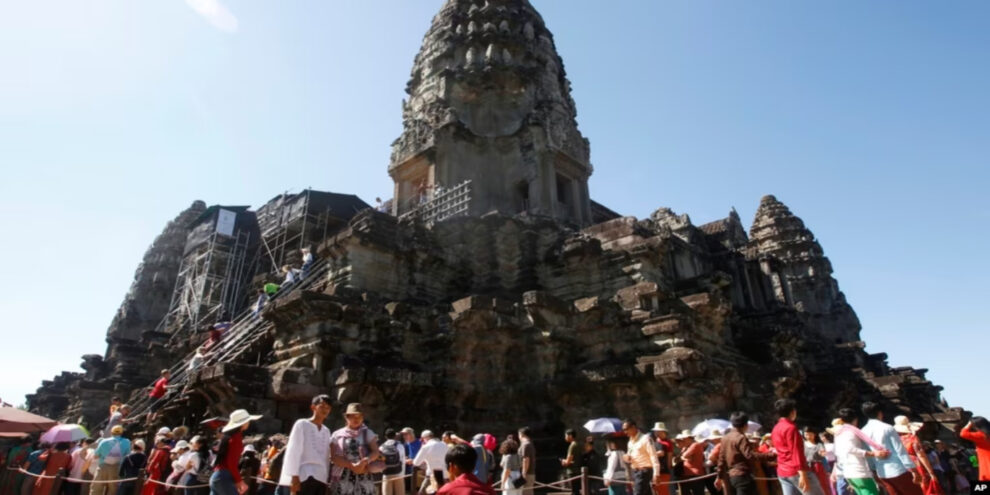PHNOM PENH, CAMBODIA — The Siem Reap-Angkor International Airport has officially opened, raising hopes of a rebound in tourism to the famed Angkor archaeological complex.
Cambodian officials hailed the $1.1 billion airport as the latest China-backed boost to the country’s economy, though analysts said the deal to build and operate the airport carries potential risks.
In a ceremony marking the first flight at the airport on Oct. 16, Vongsey Visoth, deputy prime minister in charge of the Office of the Council of Ministers, called it a “historic achievement” born from Phnom Penh’s ironclad friendship with Beijing.
The construction of the airport began in March 2020. Located about 40 kilometers from the city of Siem Reap, the new facility is expected to greatly increase the area’s capacity for international flights, even as tourism remains far below pre-pandemic levels.
The airport was built significantly farther away from the ancient temples — nearly an hour from Angkor Wat, compared with about 15 minutes for the old airport — after warnings that increased air traffic was taking an environmental toll on the ruins.
UNESCO designated Angkor Wat a World Heritage Site in December 1992, describing it as one of the most important archaeological sites in Southeast Asia. It covers some 400 square kilometers, and contains remains of the Khmer Empire, from the 9th to the 15th century, according to the UNESCO World Heritage Convention.
But more than 10 years before the pandemic, the World Bank warned of the danger to the complex from too much tourism, saying, according to the Phnom Penh Post, that some parts of the complex were sinking into their foundations as local hotels and other developments drained underground reservoirs.
That warning did not deter the Cambodian government, which began eyeing a new airport about 13 years ago. China’s Belt and Road Initiative (BRI), which in recent years has paid for major highways, bridges and special economic zones throughout the country, eventually funded the new airport.
The airport was developed mainly by Chinese firm Yunnan Investment Group, along with two other firms from Siem Reap province, according to the Cambodian government. The facility will be run under a 55-year build-operate-transfer agreement, meaning the Chinese firms will manage the airport until around 2078, when it is expected to revert to Cambodian management.
Cambodian officials have said BRI projects are driving much-needed development of the country’s infrastructure, and largely shrugged off concerns about the environmental impact, construction quality or financial risks.
Carl Thayer, professor emeritus of politics at the University of New South Wales Canberra, said the BRI infrastructure projects will continue to contribute positively to Cambodia’s economic growth.
“But the cost of repaying loans, maintenance and repair will fall on the Cambodian government. There is also the risk that Chinese companies may fail to deliver due to their own economic difficulties,” he said in an email to VOA Khmer.
Beside the positive developmental impact of the BRI in Cambodia, he added, there are some negative impacts. He pointed to the coastal town of Sihanoukville, which has been a main target of Chinese investment over the past decade.
“While not directly part of the BRI, development of Sihanoukville illustrates the downside of Chinese funding. Sihanoukville has become a virtual Chinese enclave where local residents have been marginalized,” Thayer said. He cited a reported rise in crime, corruption, kidnapping and human trafficking in the coastal hub.
The Chinese Embassy in Phnom Penh didn’t respond to VOA Khmer’s inquiries via email.
Cambodia’s tourism sector is struggling badly. Travel to Siem Reap remains almost 70% lower than it was before the COVID-19 pandemic, when the tourism hub welcomed 3.9 million annual air passengers and about 100 daily flights, according to Mao Havannall, minister in charge of the Secretariat of State for Civil Aviation.
Officials have pointed to Russia’s war in Ukraine and the global economic downturn as drags on the tourism sector since the pandemic travel controls ended. The increase in Chinese nationals being trafficked in online scamming rings in Cambodia has also reportedly become a deterrent to would-be visitors.
Havannall said at the opening ceremony that he was hopeful the new airport would reverse these trends.
“Even though there are currently only 34 daily flights, or 32% of 2019, we still hope that the brand-new infrastructure of Angkor International Airport in Siem Reap Angkor will be sufficient to attract domestic and international airlines flights — especially flights from China,” said Havannall.
Chhay Sivlin, president of the Cambodian Tourism Association, told VOA Khmer that she expected Cambodia’s tourism industry to benefit from the addition of a modern, large, new airport.
So Lyhong, a researcher at Future Forum think tank in Phnom Penh, also predicted the airport would provide an economic boost, both by increasing tourism and providing local job opportunities.
While he sees myriad benefits from China’s BRI projects in Cambodia, he said the lack of public information on the deals remained very concerning.
“I think the access to the information is very important, where the public needs to know what the country is encountering with the BRI projects,” he said. “What are the impacts of the projects on the areas? And the use of the project financing, is it used in the correct way or not?”
Source : VOA News















